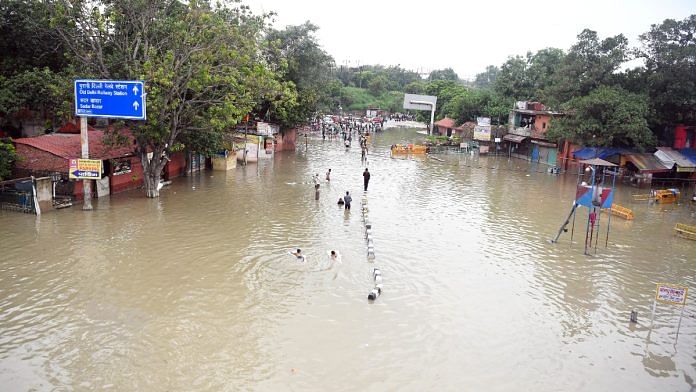New Delhi: Holding the Delhi government responsible for alleged lapses, Lieutenant Governor V. K. Saxena has listed out major factors that caused flooding in parts of the national capital last month, in a letter to Chief Minister Arvind Kejriwal Thursday.
In the letter, seen by ThePrint, Saxena said that out of the 44 kilometres of the Yamuna in Delhi, the 22 km stretch from Wazirabad to Okhla had 18 major obstructions, which hindered the flow of water.
The L-G flagged the urgent need of an advance flood management plan for Yamuna Bazar and other low-lying areas, and suggested that Delhi’s “long-pending” drainage master plan be put in place at the earliest, along with detailed drainage patterns.
Large parts of north and east Delhi — including the Red Fort and Rajghat areas — were flooded last month after the Yamuna’s water levels rose to a record high of 208.66 metres, a first since 1978.
Heavy discharge of water from the Hathnikund barrage in Haryana, along with jammed sluice gates at the city’s ITO barrage, absence of adequate drainage infrastructure and encroachments on the Yamuna floodplains were reported as the many factors that resulted in the flooding.
In his letter, the L-G said Delhi government departments were indulging in the “unprofessional practice” of not clearing construction and demolition waste, as well as other waste from sites where work on bridges was being executed, and this further obstructed the flow of the river.
“The river suffers from a heavy accumulation of silt over the years due to lack of desilting works by government agencies,” he stated, while recommending that these works be carried out at the earliest.
The “man-made” obstructions, the L-G further noted, had reduced the velocity of water in the Yamuna, and subsequently resulted in increased water levels that remained within the city limits for an additional “six hours”.
“The Najafgarh drain, which brings the maximum discharge from the city into the Yamuna, is filled with silt and garbage to the tune of 108 lakh metric tonnes. This severely affects the water-holding/carrying capacity of this 57-km-long channel,” the letter said.
ThePrint reached a spokesperson of the Aam Aadmi Party (AAP)-led Delhi government for comment via messages but no response was received till the time of publishing this report. This report will be updated if and when a response is received.
Also Read: Why does Yamuna overflow? Encroached floodplains & multiple barrages restricting river flow to blame
‘Single ownership of Yamuna’
According to Saxena, a detailed annual flood control plan for Delhi should be made available in time and measures should be put in place by 10 June every year, around 20 days prior to the onset of the monsoon in the north of India.
Further, the L-G recommended that permanent ownership of the Yamuna should be given to one government department, while other stakeholder agencies should be assigned specific responsibilities.
Similarly, he recommended “handing over all pumping installations at regulator locations to a single government department to enhance operational and maintenance efficiency”.
As of now, jurisdiction over the Yamuna is divided among multiple government agencies. This is unlike that of the Yamuna floodplains, where ownership lies with the Delhi Development Authority.
Saxena’s letter stated that there should be zero tolerance towards encroachment on the floodplains.
“There is a need to carry out a fresh topographical, hydrodynamic and hydrographic study to plan required remedial measures to cater for discharge of up to approximately 10 lakh cusec (of water) from Hathnikund in future,” it added.
(Edited by Nida Fatima Siddiqui)
Also Read: In the same boat, yet not — surviving the Delhi floods, a tale of two localities



